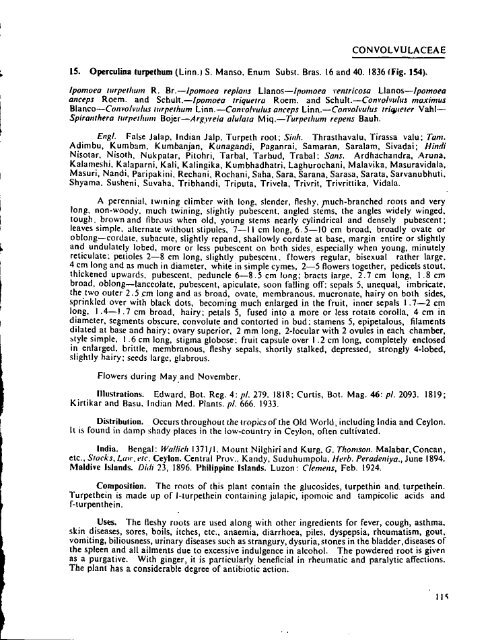,r\/*> - National Science Foundation
,r\/*> - National Science Foundation
,r\/*> - National Science Foundation
You also want an ePaper? Increase the reach of your titles
YUMPU automatically turns print PDFs into web optimized ePapers that Google loves.
CONVOLVULACEAE<br />
15. Operculina turpethum (Linn.) S. Manso. Enum Subst. Bras. 16 and 40. 1836 (Fig. 154).<br />
Ipomoea turpethum R. Br.—ipomoea re plans Llanos—Ipomoea ventricosa Llanos—Ipomoea<br />
anceps Roem. and Schult.—Ipomoea triquetra Roem. and Schult.—Convolvulus maximus<br />
Blanco—Convolvulus turpethum Linn.—Convolvulus anceps Linn.—Convolvulus triqjieter Vahl—<br />
Spiranthera turpethum Bojer—Argyreia alulata Miq.—Turpethum repens Bauh.<br />
Engl. False Jalap, Indian Jalp, Turpeth root; Sinh. Thrasthavalu, Tirassa valu; Tarn.<br />
Adimbu, Kumbam, Kumbanjan, Kunagandi, Paganrai, Samaran, Saralam, Sivadai; Hindi<br />
Nisotar, Nisoth, Nukpatar, Pitohri, Tarbal, Tarbud, Trabal; Sans. Ardhachandra, Aruna,<br />
Kalameshi, Kalaparni, Kali, Kalingika, Kumbhadhatri, Laghurochani, Malavika, Masuravidala,<br />
Masuri, Nandi, Paripakini, Rechani, Rochani, Saha, Sara, Sarana, Sarasa, Sarata, Sarvanubhuti,<br />
Shyama, Susheni, Suvaha. Tribhandi, Triputa, Trivela, Trivrit, Trivrittika, Vidala.<br />
A perennial, twining climber with long, slender, fleshy, /nuch-branched roots and very<br />
long, non-woody, much twining, slightly pubescent, angled stems, the angles widely winged,<br />
tough, brown and fibrous when old. young stems nearly cylindrical and densely pubescent;<br />
leaves simple, alternate without stipules, 7—11 cm long, 6.5—10 cm broad, broadly ovate or<br />
oblong—cordate, subacute, slightly repand, shallowly cordate at base, margin entire or slightly<br />
and undulately lobed, more or less pubescent on both sides, especially when young, minutely<br />
reticulate; petioles 2—8 cm long, slightly pubescent, flowers regular, bisexual rather large,<br />
4 cm long and as much in diameter, white in simple cymes, 2—5 flowers together, pedicels stout,<br />
thickened upwards, pubescent, peduncle 6—8.5 cm lung; bracts large, 2.7 cm long, 1.8 cm<br />
broad, oblong—lanceolate, pubescent, apiculate, soon falling off; sepals 5, unequal, imbricate,<br />
the two outer 2.5 cm long and as broad, ovate, membranous, mucronate, hairy on both sides,<br />
sprinkled over with black dots, becoming much enlarged in the fruit, inner sepals 1.7—2 cm<br />
long, 1 .4—1.7 cm broad, hairy; petals 5, fused into a more or less rotate corolla, 4 cm in<br />
diameter, segments obscure, convolute and contorted in bud; stamens 5, epipetaious, filaments<br />
dilated at base and hairy; ovary superior, 2 mm long, 2-locular with 2 ovules in each chamber,<br />
style simple, 1 .6 cm long, stigma globose: fruit capsule over I .2 cm long, completely enclosed<br />
in enlarged, brittle, membranous, fleshy sepals, shortly stalked, depressed, strongly 4-lobed,<br />
slightly hairy; seeds large, glabrous.<br />
Flowers during May and November.<br />
Illustrations. Edward, Bot. Reg. 4: pi. 279. 1818; Curtis, Bot. Mag. 46: pi. 2093. 1819;<br />
Kirtikar and Basu. Indian Med. Plants, pi. 666. 1933.<br />
Distribution. Occurs throughout the tropics of the Old World, including India and Ceylon.<br />
It is found in damp shady places in the low-country in Ceylon, often cultivated.<br />
India. Bengal: Wallich 1371/1. Mount Nilghiriand Kurg, G. Thomson. Malabar,Concan,<br />
etc.. Stocks, Law. etc. Ceylon. Central Prov., Kandy, Suduhumpola, Herb. Peradeniya., June 1894.<br />
Maldive Islands. Didi 23, 1896. Philippine Islands. Luzon: Clemens, Feb. 1924.<br />
Composition. The roots of this plant contain the glucosides, turpethin and. turpethein.<br />
Turpethein is made up of 1-turpethein containing jalapic, ipomoic and tampicolic acids and<br />
f-turpenthein.<br />
Uses. The fleshy roots are used along with other ingredients for fever, cough, asthma,<br />
skin diseases, sores, boils, itches, etc., anaemia, diarrhoea, piles, dyspepsia, rheumatism, gout,<br />
vomiting, biliousness, urinary diseases such as strangury, dysuria, stones in the bladder,diseases of<br />
the spleen and all ailments due to excessive indulgence in alcohol. The powdered root is given<br />
as a purgative. With ginger, it is particularly beneficial in rheumatic and paralytic affections.<br />
The plant has a considerable degree of antibiotic action.<br />
11 ^
















